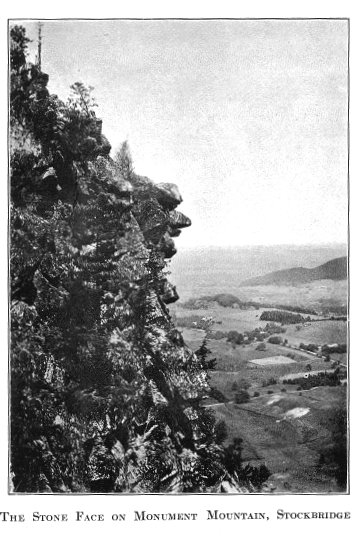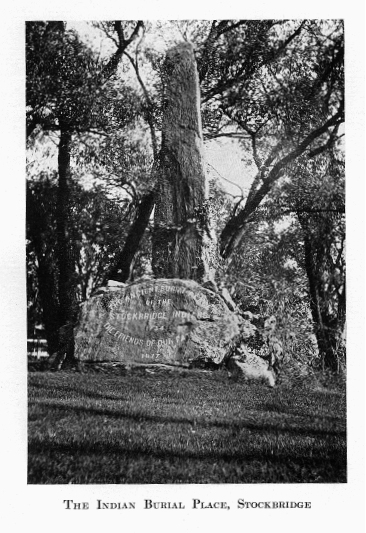Chapter 28 |
|
Chapter XXVIII Monument Mountain The glory of the Stockbridge landscape is Monument Mountain, a mountain so famed in poetry, and so enwreathed in dim tradition and antiquarian lore, that no visitor to the town feels at liberty to depart without making its acquaintance. The best point in the village from which to view it is the level plateau in the rear of the Congregational Church. It is there seen rising above the level meadows of the Housatonic, a bold, defiant, rugged mass of quartz rock, thrown up by some giant upheaval of nature, and left to charm the lovers of the picturesque and excite the speculation of the curious. The mountain is peculiar in its conformation; nearly all its brothers, and there are many of them in this region of hills and mountains, are round topped, and covered quite to their summits with a large growth of forest trees; but the summit of Monument Mountain is bold and barren of verdure, broken and fissured, and furnished with "incredible pinnacles" that prick into the blue heavens. It is not an easy matter to climb these jagged masses, but when the feat is accomplished 209 |
|
Monument Mountain one of the most charming views imaginable rewards the effort. All about us are "The bare old cliffs,
Below is the valley of the Housatonic with the
beautiful river itself winding through its emerald fields, in appearance
like a ribbon of silver unrolled, and The mountain derives its name from a curious pillar on its southern slope, raised by the Indians for some unknown purpose, which was still standing when the 210 |
|
|
|
Monument Mountain white men first came to this region. There are many traditions extant as to the origin of this pillar. Bryant, who was familiar with the mountain, has voiced the popular tradition in his beautiful poem called "Monument Mountain," a poem so familiar to all that I need give but the briefest possible paraphrase:In early days a beautiful Indian maiden was so unfortunate as to fall in love with her cousin — a love deemed illegal by these stern tribes. She struggled long with her unfortunate passion, but in vain; at length overcome with despair and shame she climbed one day the dizzy height of this mountain precipice accompanied only by a friend, "a playmate of her young and innocent years." On the verge of the precipice the friends sat down and"Sang all day old songs of love and death, And decked the poor wan victim’s hair with flowers, And prayed that safe and swift might be her way To the calm world of sunshine where no grief Makes the heart heavy and the eyelids red." And then— "When the sun grew low, And the hill shadows long, she threw herself From the steep rock and perished. There was scooped Upon the mountain’s southern slope a grave, And there they laid her in the very garb With which the maiden decked herself for death. And o’er the mould that covered her the tribe Built up a simple monument — a cone Of small loose stones. * * * 211 |
|
Monument Mountain but since Bryant wrote the antiquaries have been busy, and they say that the legend is only a beautiful myth after all — a simple impossibility, in fact, since it was not the custom of the River Indians to commemorate either men or events by the erection of memorial piles. As to the real origin or use of the pillar much legendary lore has been gathered, which would be found vastly interesting no doubt, but of which I can only give an epitome.As early as 1785 one of the early explorers, writing from Indiantown, thus refers to the monument: "Some say it is raised over the first sachem who died after the Indians came into this region. Each Indian, as he goes by, adds a stone to the pile; but Captain Konkapot (chief of the Housatonicks) tells me it marks the boundary of land agreed on in a treaty with the Mohawks, the Mohawks being entitled to all land within a day’s journey of the pile." The Rev. John Sergeant, on the occasion of his first visit to the Stockbridge Indians, in 1784, passed by the monument, and thus refers to it: "There is a large heap of stones — I suppose ten cartloads — in the way to Waahtukook, which the Indians have thrown together as they passed by the place, for it used to be their custom every time any one passed by to throw a stone at it. But what was the end of it they cannot tell; only they say their fathers used to do so, and they do it because it was the custom of212 |
|
their fathers. But Ebenezer (the Indian interpreter) says he supposes it is designed to be an expression of their gratitude to the Supreme Being that He had preserved them to see the place again." Another tradition is to the effect that on one occasion the territory of the Mubhekunnucks was invaded by a powerful enemy from the West; that the Muhbekunnucks laid an ambush for their enemies in this mountain and defeated them there with great slaughter, and that this pile was raised to commemorate the event. But the writer who has treated of the subject most at length was the Rev. Gideon Hawley of Mashpee, Mass., for some time a missionary to the Stockbridge Indians, whose knowledge of Indian rites and customs was not inconsiderable. In his missionary tours he discovered several of these monuments and thus describes them: "We came to a resting-place, breathed our horses, and slaked our thirst at a stream, when we perceived our Indian looking for a stone which he cast to a heap that had for ages been accumulated by passengers like him who was our guide. We inquired why he observed this rite. His answer was that his fathers had practised it and enjoined it on him; but he did not like .to talk on the subject. I have observed in every part of the country, among every tribe of Indians, and among those where I now am (Mashpee) such heaps of stones or sticks collected on like occasions as above. The 213 |
|
largest heap I ever observed is that large collection of small stones on Monument Mountain, between Stockbridge and Barrington. We have a sacrifice rock, as it is termed, between Sandwich and Plymouth, to which stones and sticks are always cast by Indians who pass it. This custom or rite seems to be an acknowledgment of an invisible being, we may style him the unknown God, whom the people worship. This heap is his altar. The stone that is collected is the oblation of the traveler, which, if offered with a good mind, may be as acceptable as a consecrated animal."The monument stood on the southern slope of the mountain. It was circular at the base, with a diameter of from eight to ten feet, and as it approached the apex it assumed a conical form. It was thrown down about forty years ago by a band of covetous marauders in the hope of finding a treasure trove secreted beneath it, and now lies a shapeless mass of stone. It is a comfort to know, however, that the freebooters gained nothing by their vandalism. But, although the pile is overthrown, the poetic and legendary associations that cluster about it will always render it an object of interest to intelligent tourists. 214 |
|
|

